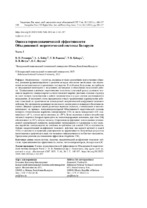Оценка термодинамической эффективности Объединенной энергетической системы Беларуси. Часть 2

Date
2023Publisher
Another Title
Assessment of Thermodynamic Efficiency of the Belarusian Energy System. Part 2
Bibliographic entry
Оценка термодинамической эффективности Объединенной энергетической системы Беларуси. Часть 2 = Assessment of Thermodynamic Efficiency of the Belarusian Energy System. Part 2 / В. Н. Романюк [и др.] // Известия высших учебных заведений и энергетических объединений СНГ. Энергетика. – 2023. – № 2. – С. 141-157.
Abstract
Энергосистема – структура, входящая в число сложнейших искусственных объектов, успешное функционирование и развитие которых абсолютно необходимо для обеспечения жизнедеятельности современного государства. В этой связи, безусловно, востребован ее непрерывный мониторинг с получением достоверных и объективных показателей работы. Традиционные ключевые энергетические показатели (удельный расход условного топлива на выработку электроэнергии и отпуск тепловой энергии) для таких сложных структур не дают полного представления о работе энергосистемы и в ряде случаев рассчитываются некорректно. В настоящей статье предлагается к числу традиционных характеристик добавить известный, но практически не используемый эксергетический коэффициент полезного действия. Его применение расширяет возможности мониторинга и повышает объективность оценки. Впервые проведен анализ различных периодов (годового, отопительного и межотопительного) на примере теплоэлектроцентралей Объединенной энергетической системы Беларуси. Относительная выработка электроэнергии ТЭЦ до ввода Белорусской АЭС оценивалась в ≈45 %, а после ввода снизилась до ≈39 %. Более половины годового потребления тепловой энергии в Беларуси приходится на теплогенерирующие источники, при этом ТЭЦ обеспечивают до 88 % отпуска теплоты. Определены коэффициент использования установленной электрической мощности, коэффициент теплофикации и усредненная за год удельная выработка электроэнергии на тепловом потреблении для каждой ТЭЦ в отдельности. Найден эксергетический коэффициент полезного действия для каждой крупной и малой ТЭЦ в отдельности и проведено ранжирование их эффективности. Полученные результаты представлены в графическом виде, что повышает информативность и облегчает восприятие. Предложены решения для повышения эффективности работы ТЭЦ.
Abstract in another language
The energy system is a structure that is among the most complex artificial objects, the successful functioning and development of which is absolutely necessary to ensure the livelihoods of a modern state. In this regard, its continuous monitoring with obtaining reliable and objective performance indicators is undoubtedly in demand. Traditional key energy indicators (specific consumption of conventional fuel for electricity generation and heat release) do not give a complete picture of the operation of the power system for such complex structures and in some cases are calculated incorrectly. The present paper proposes to add a well-known, but practically unused exergetic efficiency coefficient to the range of traditional characteristics. Its application expands the monitoring capabilities and increases the objectivity of the evaluation. For the first time, the analysis of various periods (annual, heating and inter-heating) was carried out on the example of thermal power plants (CHP) of the Unified Energy System of Belarus. The relative power generation of the CHP before the commissioning of the Belarusian NPP was estimated at ≈45 %, and after commissioning it decreased to ≈39 %. More than half of the annual consumption of thermal energy in Belarus is accounted for by heat-generating sources, while thermal power plants provide up to 88 % of heat output. The installed electric capacity utilization factor, the extraction factor and the average annual specific generation of electricity on thermal consumption for each CHP separately have been determined. The results are presented graphically, which makes the content more informative and facilitates the perception. Solutions have been proposed to improve the efficiency of the CHP.
View/
Collections
- № 2[6]
